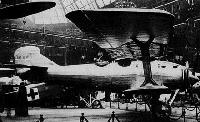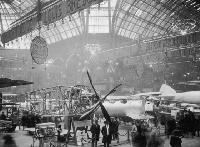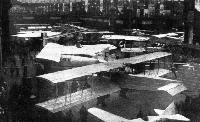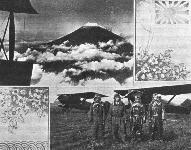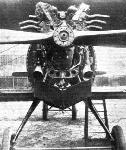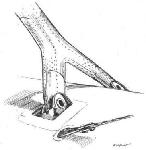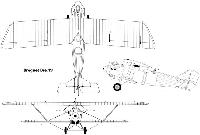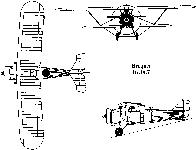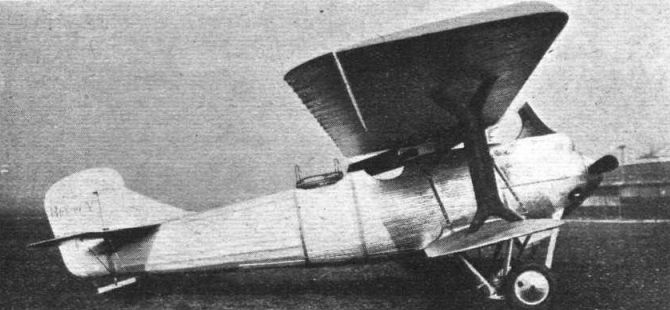
Варианты
- Breguet - Br.19 - 1922 - Франция
- Breguet - Br.19GR Grand Raid / Br.19TF Super Bidon - 1925 - Франция
- Breguet - Br.26T - 1926 - Франция
- Breguet - Br.280 - 1928 - Франция
Br.19
Разведчик и легкий бомбардировщик. Одномоторный цельнометаллический биплан с неубирающимся шасси. Спроектирован в КБ фирмы "Сосьете аноним дез ателье д'авьясьён Луи Брэге" под руководством М. Вюллерме. Испытания первого опытного образца Br.XIX проводились в марте 1922 г. Серийное производство машины было начато осенью 1924г.
Br.XIX строился заводами "Брэге" (Виллакублэ), SABCA (Харен), CASA (Мадрид, Испания), "Икарус" (Земун, Югославия), "Државна фабрика авиона" (Кральево, Югославия). В общей сложности изготовлено около 2000 экз. Экипаж самолета - 2 чел. Вооружение 3 - 4x7,69(7,62), бомбы до 100 кг (А2) или 500 кг (В2). Двигатель - в зависимости от модификации и страны-заказчика.
Br.XIX (впоследствии переименован в Br. 19) состоял на вооружении во Франции с декабря 1924 г., в Югославии, Китае, Греции, Турции, Польше, Испании, Аргентине - с 1925 г., в Румынии - с 1926 г., в Бельгии - с 1927 г., в Венесуэле, Боливии, Бразилии - с 1928 г.
Выпускались основные серийные модификации военного назначения:
- Br.19 тип 1925 г., в вариантах А2 (разведчик) и В2 (легкий бомбардировщик), отличавшихся оборудованием;
- Br.19 тип 1926 г., усиленный, с увеличенным объемом бензобаков; также в вариантах А2 и В2; моторы Рено 12Kd, LD 12Db, LD12Eb для Франции (в частях переоснащались также Фарман 12W), экспортные - Рено 12Kb (Бразилия), HS 12Hb (Греция), HS 12Hb (Бельгия), GR 9Ab (Югославия);
- Br.19ter с мотором HS 12Lb, крылом и оперением от рекордного самолета "Бидон"; для Польши выпущен как Br.19B2/GR с мотором LD 12Eb, дальний разведчик;
- Br.19.7 с мотором HS 12Nb, измененной коробкой крыльев;
- Br.19.8 с мотором R-1820-F56, югославская модификация на базе Br.19.7.
Br.19 впервые был испытан в боевой обстановке испанскими ВВС во время колониальной войны в Марокко, в июле 1925г. В 1926-29 гг. они использовались в боевых действиях между Боливией и Парагваем. В 1930 г. аргентинские Br.19 приняли активное участие в государственном перевороте. В Китае несколько машин имелись в войсках генерала Чжан Цзолина во время боев с ОДВА на Китайско-Восточной железной дороге (осень 1929 г.). Позднее китайские авиаторы воевали на них в Манчжурии против японцев. В 1932 г. вспыхнула новая война между Боливией и Парагваем в Чако и самолеты "Брэге" опять использовались в ней.
Во Франции в конце 20-х годов Br.19 являлся основным типом разведчика и легкого бомбардировщика. С ноября 1931 г. он поступил также на вооружение эскадрилий ночных истребителей, но затем начал выводиться "во вторую линию" и к 1936 г. полностью исчез из строевых частей.
Во время гражданской войны в Испании Br.19 использовали обе стороны: республиканцы - до декабря 1936 г., франкисты - до мая 1937 г. Осенью 1936 г. на этих самолетах воевали в Испании советские летчики. В Бельгии Br.19 сняли с вооружения в 1935 г., в Польше - в 1936 г. убрали из строевых частей, а в начале 1939 г. списали.
К началу Второй мировой войны бипланы "Брэге" остались только в Греции и Югославии. Греческие Br.19 в октябре 1940-го бомбили днем итальянские колонны на албанской границе. При этом они несли большие потери от истребителей противника. К моменту нападения немцев самолетов этого типа в строю уже не осталось.
Югославские машины в большинстве были уничтожены на земле в первые дни агрессии Германии в апреле 1941 г. Уцелевшие Br.19 наносили удары по войскам противника, мостам и переправам. В частности, они бомбили мосты на реках Драва и Вардар. Захваченные немецкими войсками "брэге" были переданы марионеточному правительству Хорватии и использованы против югославских партизан. Последние из них летали до апреля 1945 г.
Захваченные бойцами НОАЮ в мае 1942 г. Br.19 стали первыми самолетами новых ВВС Югославии.
Производство Br. 19 завершили в Бельгии в 1930 г., во Франции - в 1932 г., в Испании - в октябре 1935 г., в Югославии - в ноябре 1937 г.
Br.19B2 type 1926||
Размах:||14,96 м
Длина:||9,45 м
Моторы, количество х мощность:||1x513 л.с.
Взлетная масса, максимальная:||2347 кг
Максимальная скорость:||235 км/ч
Практический потолок:||6900 м
Дальность:||1200 км
Описание:
- Br.19
- Breguet Bre.19
- Flight, November 1921
The Paris Aero Show - 1921 - Flight, August 1923
GOTHENBURG International Aero Exhibition 1923 - Flight, June 1924
THE THIRD INTERNATIONAL AERO SHOW AT PRAGUE - Flight, December 1924
The Paris Aero Show 1924 - Flight, December 1926
The Paris Aero Show 1926
Фотографии
-
АвиаМастер 2001-04 / В.Котельников - Путешественник и воин /Раритеты/
Br 19A2 из состава 2-й эскадрильи 51-й эскадры ВВС Франции, 1932г.
-
АвиаМастер 2001-04 / В.Котельников - Путешественник и воин /Раритеты/
Br 19B2 из состава 5-й эскадрильи 11-го авиаполка ВВС Франции, 1928г.
-
Мировая Авиация 72
Bre.19В.2 с эмблемой 5-й эскадрильи 11-го авиаполка французских ВВС, базировавшегося в 1928 году в Мец-Фрекати.
-
Авиация и Космонавтика 2024-07 / В.Морозов - Военная авиация Польши 1918-2024гг. (1)
Регистрационный номер: 60.59 Легкий бомбардировщик-разведчик Бреге XIX
-
АвиаМастер 2001-04 / В.Котельников - Путешественник и воин /Раритеты/
Польский Br 19, принадлежавший в середине 1930-х годов фабрике аэростатов и парашютов WBS.
-
Мировая Авиация 148
Аэроплан Breguet Bre.19A2, на котором Орлинский совершил рекордный перелет Варшава - Токио. Вариант A2 изначально предназначался для разведки.
-
АвиаМастер 2001-04 / В.Котельников - Путешественник и воин /Раритеты/
Br 19 23-й авиагруппы испанских ВВС, 1935г.
-
АвиаМастер 2001-04 / В.Котельников - Путешественник и воин /Раритеты/
Br 19 испанских республиканских ВВС, 1936г.
-
АвиаМастер 2001-04 / В.Котельников - Путешественник и воин /Раритеты/
Br 19 школы летчиков-наблюдателей франкистских ВВС, 1938г.
-
АвиаМастер 2001-04 / В.Котельников - Путешественник и воин /Раритеты/
Br 19.7 ВВС Турции, 1934г.
-
Air Enthusiast 1971-07 / ??? - A pictorial history of Turkish Military Aviation
Breguet XIX.7 reconnaissance-bomber, 1935.
-
АвиаМастер 2001-04 / В.Котельников - Путешественник и воин /Раритеты/
Breguet 19.8 из состава 6-й "противопартизанской" эскадрильи 2-й авиагруппы хорватских ВВС, 1943г.
-
Мировая Авиация 109
Изображенный на рисунке Bre.19A.2 и установленный на нем двигатель Jupiter были построены по лицензии в Югославии. Около 100 этих самолетов продолжали нести службу в 1939 году, хотя их основной задачей стала уже не разведка, а связь и обучение. Обратите внимание, что самолет оснащен крюком для подъема капсул с донесениями.
-
Flight 1923-07 / Flight
The Breguet type XIX A.2 Sesquiplan, with 450 h.p. Renault. A military machine of metal construction.
-
Мировая Авиация 43
Ноябрь 1922г.: на VII салоне воздухоплавания в Париже представлен первый прототип самолета Breguet 19 А2 с двигателем Breguet-Bugatti мощностью 450 л. с.
-
Flight 1921-11 / Flight
The Breguet "Sesquiplan," type "19 A.2," is a "Grande Reconnaissance" two-seater fighter, constructed of metal throughout except for the wing covering.
-
Мировая Авиация 73
Ноябрь 1921г.: на парижском авиасалоне впервые публично представлен прототип французского самолета Breguet 19, созданного на базе Breguet 14 военного времени. Этот удачный легкий разведчик-бомбардировщик серийно строился во Франции до 1928 года, а в других странах выпускался по лицензии еще дольше. На специализированном варианте самолета было установлено несколько мировых рекордов дальности полета.
-
Flight 1924-12 / Flight
THE NINTH INTERNATIONAL AERO EXHIBITION, PARIS: General view of the Grand Palais, showing the striking scheme of decoration (carried out in yellow and blue), which combines beauty with utility. In the view (looking north) will be seen the S.I.M.B., Latecoere, Capt. D'Oisy's Breguet, etc.
Другие самолёты на фотографии: Bernard Bernard V - Франция - 1924Latecoere L.15 - Франция - 1924Latecoere L.16 - Франция - 1923
-
Flight 1923-08 / Flight
PARIS TOKIO FLIGHT: The Breguet XIX Sesquiplan, which is the type of machine, fitted with a 400 h.p. Lorraine-Dietrich engine, Lieut. Pelletier d'Oisy is flying.
-
АвиаМастер 2001-04 / В.Котельников - Путешественник и воин /Раритеты/
Французский Br 19B2 с двигателем "Испано-Сюиза" в 650 л.с. и двумя 100-кг бомбами на подкрыльевых подвесках.
-
Моделист-Конструктор Ближние разведчики, корректировщики и штурмовики Второй мировой войны
Самолет Br.XIX с мотором LD 12Eb
-
Мировая Авиация 148
Модифицированный аэроплан Bre.19A2 большую часть маршрута от Токио до Варшавы летел с сильно поврежденным нижним крылом. В 1920-1930 годах Bre.19 благодаря своей огромной дальности полета установил немало рекордов.
-
Air Enthusiast 2000-11 / L.Andersson - Iranian Eagles
A Breguet 19, probably before delivery. A small serial number (292) is painted on the fuselage, and the Persian lion and sun emblem and national colours are on the rudder
-
Flight 1924-12 / Flight
The Breguet XIX made famous by Lieut. Peletier d'Oisy's flight to China. With exception of the wing covering, and that of the rear portion of the fuselage, this machine is built entirely of metal.
-
Flight 1924-06 / Flight
THE BREGUET XIX, 400 H.P. LORRAINE-DIETRICH ENGINE: This actual machine was used by Lieut. Pelletier d'Oisy on his flight to the East.
-
АвиаМастер 2001-04 / В.Котельников - Путешественник и воин /Раритеты/
Br 19B2 с мотором "Рено", принадлежавший одной из французских бомбардировочных эскадрилий.
-
АвиаМастер 2001-04 / В.Котельников - Путешественник и воин /Раритеты/
Br 19B2, проходивший испытания в Советском Союзе. Машина окрашена в защитный цвет и не несет никаких эмблем или опознавательных знаков.
-
Air Enthusiast 1971-07 / ??? - A pictorial history of Turkish Military Aviation
Twenty Breguet XIXs were purchased in the late ’twenties, being supplemented in 1933 by 50 of the later Breguet XIX.7s.
-
Авиация и Космонавтика 2024-07 / В.Морозов - Военная авиация Польши 1918-2024гг. (1)
Бреге XIX в составе ВВС Польши
-
Авиация и Космонавтика 2024-08 / В.Морозов - Военная авиация Польши 1918-2024гг. (2)
Звено разведчиков «Бреге» XIX ВВС Польши в тренировочном полёте. Начало 1930‑х гг.
-
Flight 1932-10 / Flight
A FRENCH RECORD BREAKER: The Breguet type 19-8 Observation plane (660 h.p. Gnome-Rhone "Mistral Major" K-14) on which Capt. Signorin recently established two records, viz., 10,400 m. (34,120 ft.) with 500 kg. and 9,400 m. (30,841 ft.) with 1,000 kg.
-
АвиаМастер 2001-04 / В.Котельников - Путешественник и воин /Раритеты/
Br 19B2 Французских ВВС в полете.
-
АвиаМастер 2001-04 / В.Котельников - Путешественник и воин /Раритеты/
Этот невооруженный Br 19 использовался французскими ВВС для подготовки курсантов.
-
Мировая Авиация 109
Этот Bre.19, построенный по лицензии фирмой CASA и оснащенный двигателем Elizalde А-4, в 1935 году входил в состав 22-й группы армейской авиации, базировавшейся в Табладе, Севилья. Самолеты этого типа сыграли важную роль во время гражданской войны в Испании.
-
Aeroplane Monthly 1986-09 / Personal album
Не так уж много выпало славы на долю французского Br-19, хотя он и поучаствовал в нескольких вооружённых конфликтах, имевших место в 20-30-х годах. На фото самолёт ВВС Испанской Республики.
The Breguet 19 was licence-built at Madrid-Getafe from 1926 and equipped Groups 21, 22, 23 and 31; others were used at training establishments. -
Мировая Авиация 109
Аргентинский заказ на Breguet 19 стал первым в ряду заказов, сделанных государствами Латинской Америки. На этих самолетах, сфотографированных в 1935 году, установлены двигатели Lorraine-Dietrich 12Eb.
-
Мировая Авиация 109
Югославия была крупнейшим зарубежным покупателем Bre.19. Самолеты из четвертой партии, поставленной этой стране, были оснащены двигателями Gnome-Rhone Jupiter 9Ab мощностью 420 л.с. (313 кВт).
-
Flight 1926-05 / Flight
THE SPANISH FLIGHT TO MANILA: Our first picture shows Capt. Estevez (left), leader of the Madrid-Manila flight, and his mechanic Calvo, who were lost in the desert near Amman for seven days before being found by a R.A.F. pilot. The second picture shows one of the three Breguet IX machines filling up with "Shell" at Madrid prior to the start on April 5.
-
АвиаМастер 2001-04 / В.Котельников - Путешественник и воин /Раритеты/
Сценка из аэродромной жизни: техосмотр двигателя в промежутке между полетами.
-
Aeroplane Monthly 1986-09 / Personal album
The Breguet 19 was licence-built at Madrid-Getafe from 1926 and equipped Groups 21, 22, 23 and 31; others were used at training establishments.
-
АвиаМастер 2002-08 / М.Жирохов, И.Сеидов - Яростное небо Эускади /Из истории воздушных войн/
Эскадрилья республиканских "Бреге-XIX". Обратите внимание, что самолеты окрашены по разному.
-
Aeroplane Monthly 1978-05 / C.Baker - A Fairey for Athens
The Fairey, Breguet and Letov-Smolik at Tatoi Aerodrome, Athens.
Другие самолёты на фотографии: Fairey Fairey IIIF - Великобритания - 1926Letov S-16 - Чехословакия - 1926
-
Flight 1931-05 / Flight
The Belgian Army Air Corps Squadron at Manston. The machines are Breguet XIX's reconnaissance aircraft and an built in Belgium. The Squadron arrived on May 5 and spent the rest of the week visiting other R.A.F. stations.
-
Flight 1931-05 / Flight
Grp. Capt. R. C. M. Pink greeting General Gillieaux on his arrival with a squadron of the Belgian Army Air Corps at Manston.
-
Flight 1926-12 / Flight
FROM FAIR NIPON: The two Breguet biplanes, on which the Japanese pilots flew from Tokio to London in 1925, fill up with " Pratt's" before departing from Croydon.
-
Flight 1925-09 / Flight
THE TOKYO-LONDON FLIGHT: Having left the land of their sacred Fuji Yama last July, the four Japanese airmen shown above, Maj. Abe (extreme left) and Mr. Kawachi, the pilots, and Engineers Shinohara and Katagiri, are well on their way to London. The two Breguet biplanes on which they are flying will be seen behind the airmen, whilst above we show an aerial view of the beautiful Fuji Yama Mountain.
-
АвиаМастер 2007-03 / В.Толстой - В борьбе с белокитайцами /От первого лица/
Бомбардировка китайского аэродрома "Муданьцзян" - аэрофотоснимок. Самолеты "Бреге-19" стоят в капонирах.
-
Flight 1924-06 / Flight
Front View of the Breguet XIX, showing mounting Lorraine-Dietrich engine. Note the Andre retractable radiator.
-
Flight 1924-06 / Flight
One side of the undercarriage of the Breguet XIX. Note the single strut undercarriage, the streamline axle fairing, and the Artillery type wheel instead of the usual wire-spoke type.
-
Flight 1921-11 / Flight
Tail skid, rudder-crank, etc., of the Breguet "Sesquiplan."
-
Flight 1921-11 / Flight
The interplane struts of the Breguet "Sesquiplan," are forked at the ends to meet the two wing spars.
-
Flight 1923-08 / Flight
THE BREGUET SESQUIPLAN: The new type and mounting of radiator, and below the fairing around the terminal of a bracing wire.
-
Flight 1923-08 / Flight
Breguet Sesquiplan, Type XIX 450 hp. Renault
-
АэроХобби 1993-01 / И.Самарский - Самолеты с бело-красными "шаховницами" /Аэроархив/ (1)
Легкий бомбардировщик Breguet XIX B2.
-
Мировая Авиация 72
Breguet Bre.19
- Фотографии














